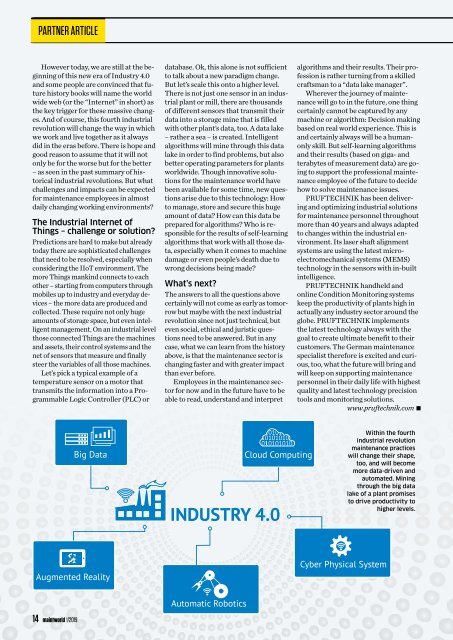Maintworld 1/2019
Condition Monitoring in the Age of the of the IIoT // Digital line of sight // Harnessing change for a successful business // Energy savings 4.0
Condition Monitoring in the Age of the of the IIoT // Digital line of sight // Harnessing change for a successful business // Energy savings 4.0
You also want an ePaper? Increase the reach of your titles
YUMPU automatically turns print PDFs into web optimized ePapers that Google loves.
PARTNER ARTICLE<br />
However today, we are still at the beginning<br />
of this new era of Industry 4.0<br />
and some people are convinced that future<br />
history books will name the world<br />
wide web (or the “Internet” in short) as<br />
the key trigger for these massive changes.<br />
And of course, this fourth industrial<br />
revolution will change the way in which<br />
we work and live together as it always<br />
did in the eras before. There is hope and<br />
good reason to assume that it will not<br />
only be for the worse but for the better<br />
– as seen in the past summary of historical<br />
industrial revolutions. But what<br />
challenges and impacts can be expected<br />
for maintenance employees in almost<br />
daily changing working environments?<br />
The Industrial Internet of<br />
Things – challenge or solution?<br />
Predictions are hard to make but already<br />
today there are sophisticated challenges<br />
that need to be resolved, especially when<br />
considering the IIoT environment. The<br />
more Things mankind connects to each<br />
other – starting from computers through<br />
mobiles up to industry and everyday devices<br />
– the more data are produced and<br />
collected. These require not only huge<br />
amounts of storage space, but even intelligent<br />
management. On an industrial level<br />
those connected Things are the machines<br />
and assets, their control systems and the<br />
net of sensors that measure and finally<br />
steer the variables of all those machines.<br />
Let’s pick a typical example of a<br />
temperature sensor on a motor that<br />
transmits the information into a Programmable<br />
Logic Controller (PLC) or<br />
database. Ok, this alone is not sufficient<br />
to talk about a new paradigm change.<br />
But let’s scale this onto a higher level.<br />
There is not just one sensor in an industrial<br />
plant or mill, there are thousands<br />
of different sensors that transmit their<br />
data into a storage mine that is filled<br />
with other plant’s data, too. A data lake<br />
– rather a sea – is created. Intelligent<br />
algorithms will mine through this data<br />
lake in order to find problems, but also<br />
better operating parameters for plants<br />
worldwide. Though innovative solutions<br />
for the maintenance world have<br />
been available for some time, new questions<br />
arise due to this technology: How<br />
to manage, store and secure this huge<br />
amount of data? How can this data be<br />
prepared for algorithms? Who is responsible<br />
for the results of self-learning<br />
algorithms that work with all those data,<br />
especially when it comes to machine<br />
damage or even people’s death due to<br />
wrong decisions being made?<br />
What’s next?<br />
The answers to all the questions above<br />
certainly will not come as early as tomorrow<br />
but maybe with the next industrial<br />
revolution since not just technical, but<br />
even social, ethical and juristic questions<br />
need to be answered. But in any<br />
case, what we can learn from the history<br />
above, is that the maintenance sector is<br />
changing faster and with greater impact<br />
than ever before.<br />
Employees in the maintenance sector<br />
for now and in the future have to be<br />
able to read, understand and interpret<br />
algorithms and their results. Their profession<br />
is rather turning from a skilled<br />
craftsman to a “data lake manager”.<br />
Wherever the journey of maintenance<br />
will go to in the future, one thing<br />
certainly cannot be captured by any<br />
machine or algorithm: Decision making<br />
based on real world experience. This is<br />
and certainly always will be a humanonly<br />
skill. But self-learning algorithms<br />
and their results (based on giga- and<br />
terabytes of measurement data) are going<br />
to support the professional maintenance<br />
employee of the future to decide<br />
how to solve maintenance issues.<br />
PRUFTECHNIK has been delivering<br />
and optimizing industrial solutions<br />
for maintenance personnel throughout<br />
more than 40 years and always adapted<br />
to changes within the industrial environment.<br />
Its laser shaft alignment<br />
systems are using the latest microelectromechanical<br />
systems (MEMS)<br />
technology in the sensors with in-built<br />
intelligence.<br />
PRUFTECHNIK handheld and<br />
online Condition Monitoring systems<br />
keep the productivity of plants high in<br />
actually any industry sector around the<br />
globe. PRUFTECHNIK implements<br />
the latest technology always with the<br />
goal to create ultimate benefit to their<br />
customers. The German maintenance<br />
specialist therefore is excited and curious,<br />
too, what the future will bring and<br />
will keep on supporting maintenance<br />
personnel in their daily life with highest<br />
quality and latest technology precision<br />
tools and monitoring solutions.<br />
www.pruftechnik.com<br />
Within the fourth<br />
industrial revolution<br />
maintenance practices<br />
will change their shape,<br />
too, and will become<br />
more data-driven and<br />
automated. Mining<br />
through the big data<br />
lake of a plant promises<br />
to drive productivity to<br />
higher levels.<br />
14 maintworld 1/<strong>2019</strong>

















